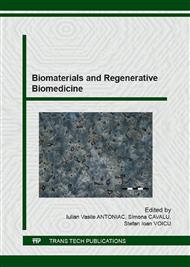p.236
p.243
p.247
p.252
p.260
p.267
p.273
p.278
p.284
Histologic Evaluation of Tertiary Dentine after Indirect Pulp Capping Procedures
Abstract:
Early carious lesions induce odontoblast stimulation in tertiary dentine formation even before the lesion reaches the dentine. The most used material for these procedures was calcium hydroxide, which was recently replaced by Mineral Trioxide Aggregate (MTA).The purpose of our study was to assess the histological characteristics of tertiary dentine induced by these materials in permanent molar teeth.We used 23 molars scheduled for extraction due to orthodontic reasons, in patients of 17-24 years of age. In a time interval of 4-8 weeks prior to extraction, occlusal cavities were prepared and filled with MTA or calcium hydroxide and glass ionomer cement.In teeth filled with MTA we noticed an early development of tertiary dentin layer, with a tubular structure, similar to secondary dentine. In the case of calcium hydroxide, the process of new dentine deposition was delayed and diffuse calcification, with formation of pulp stones was noticed.MTA proved to be superior to calcium hydroxide in inducing tertiary dentine formation, which appeared early after treatment. In time the differences in the amount of tertiary dentine between these materials are reduced, but there is a tendency of diffuse mineralization induced by calcium hydroxide.
Info:
Periodical:
Pages:
260-263
Citation:
Online since:
May 2016
Authors:
Keywords:
Price:
Сopyright:
© 2016 Trans Tech Publications Ltd. All Rights Reserved
Share:
Citation:


